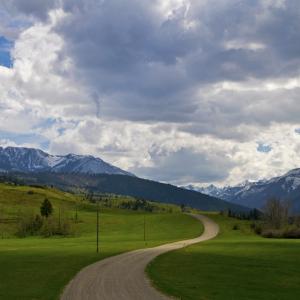An Ode to Montana's Spring
~Sean Jansen
Sitting here taking a break from outlining this exact piece, I look out my window beyond my laptop screen and desk to feel warmth in my stomach. I begin to smile as the coffee awakens me and the sun rises further and further into the sky. My eyes draw nearer to the icicles that dangle from my roof as they begin to drip from the snow-melt, cooked by the sun and pelting my roof creating the dripping sound I haven’t heard in months. My eyes peer past the icicles as I look to the range outside of town and see patches of forest and dirt with the sun melting there as well. I get a text from a friend heading up the mountain, forgetting his jacket with little care to turn around to get it. Ten minutes later, another text comes in to set up the fly rods and hit the river. Spring can be both a fickle mistress or the love of ones life, and all I can say is that my feelings are certainly leaning towards holding hands with this newly arrived season.
Spring equinox arrives March 20. Now March in Montana is undoubtedly still a winter month. Just two weeks ago we got several inches of snow, and the week or so previous broke the dip in mercury for the winter, flirting with 30 to 50 below zero. However on the contrary, the mercury does swing towards the latter end of the month coincidentally with the sun, creating both the snow-melt some desire while keeping the snow in the right places for those to get the long last lines in for the next several months.
April on a personal level is my favorite month in the state. Big Sky remains open until the last week of the month as well as many of the other resorts and lifts in the state. Meaning with the extended daylight hours and with the mountains shutting down well before sunset, one could literally hit the slopes for the first several hours of the day, with plenty of time to set up the fly rod en-route home to whichever river flows from and to the direction of home. Wildflowers begin to pop out and the 19th sparks the opening to the West Entrance of Yellowstone National Park. You can still have the opportunity for an early spring dumping of snow, sparking the joy to strap up them snow shoes or click into the cross country skis or finally start licking your chops as the running shoes get laced back on and the trails beckon with its first tracks of the spring and summer seasons.
May gets everyone on the same page for the most part, accepting the fact that summer is certainly around the corner and only the most driven and die hard skiers and snowboarders continue there pursuit upward to the last remaining depths of snow throughout the state. Trail runners, hikers, and mountain bikers rejoice as this is the swing and start of counting down those miles of footsteps and pedals. Speaking of footsteps, hunters are out as well as the spring season boasts both Turkey and Black Bear for whomever desires. The rivers sadly swell to crazy levels as snow melt is in full effect for anglers. For paddlers however, the dry suits come out, and the ride-shares get bargained for with shuttles up and down the rapids. Even surfers are out in force in particular corners.
Then June rolls around with lightening sparking the sky with electrical veins deafening even the most hard of hearing. All wildflowers are in abloom lining the trails and pastures creating a virtually green landscape. The days are almost exhausting; long and the northern lights can be seen in the corners for those looking for it. Drift boats are getting launched in full force as the trout launch themselves at the insects buzzing the surface of the remaining snow-melt that fell months ago.
June also shares the season of summer and therefore it’s also a fickle mistress, like March. In the mountains and Montana we certainly have a saying. “There are two seasons in Montana, Winter and July.” And for those who are either born and raised, been here years, or only a few months, Montana loves to throw curve balls. And if there is one piece of advice for anyone in the state, is to be sure to packed your catcher’s mitt as that is pretty much all any of us can do when weather throws what it decides to. Make the most of it and enjoy it all for what it is.
